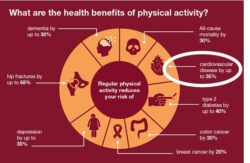Overcoming Obstacles to Regular Exercise:
Practical Solutions for a Healthier You
The Undeniable Health Benefits of Regular Physical Activity
As a doctor, I know firsthand how vital regular exercise is for our health—yet I have to admit, I’m not a fan of exercise itself. Like many of my patients, I find it tough to get started. But I love the results: better energy, better self-esteem, improved mood, and overall well-being. If you struggle with regular exercise, you’re not alone.
The reality is that exercise ranks as number one anti-aging and health preservation intervention and, despite this…it appears the hardest to implement.
Regular exercise is one of the most powerful tools we have for preventing disease and improving overall health. Here’s why it’s so crucial:
- Reduces risk of heart disease, stroke, and type 2 diabetes
- Helps maintain a healthy weight
- Improves mood and mental health
- Strengthens bones and muscles
- Enhances cognitive function as we age
- Lowers risk of certain cancers
Let’s dive into the most common obstacles people face and simple strategies to overcome them.
- Lack of Time
The Challenge: In today’s busy world, many of us feel like there just aren’t enough hours in the day. Between work, family, and personal responsibilities, finding time to exercise can seem impossible.
The Solution: The good news is that you don’t need hours in the gym to make a difference. Incorporate micro-workouts into your day—10 minutes of movement here and there add up. Try parking farther from work or walking during lunch. Schedule exercise as a non-negotiable part of your day, just like you would a meeting. - Lack of Motivation
The Challenge: Motivation is a slippery thing. It’s hard to feel driven to exercise when you don’t see immediate results or simply feel unexcited by the idea.
The Solution: Start small. Set simple, achievable goals, like walking for 15 minutes a day, and celebrate when you hit them. You’ll find that success breeds motivation. Additionally, try exercising in ways that are enjoyable—whether it’s dancing, biking, or even playing with your kids. - Physical Limitations and Health Conditions
The Challenge: If you’re dealing with chronic pain, injuries, or medical conditions, exercising can feel more like a risk than a benefit.
The Solution: Talk to your healthcare provider (that’s where I come in!) for a tailored exercise plan that works with your body’s needs. Focus on low-impact activities like swimming, cycling, or walking. The key is consistency, not intensity—doing something is always better than doing nothing. - Fear of Injury
The Challenge: Many people avoid exercise because they’re worried about getting injured, especially if they’ve had previous injuries or aren’t sure how to exercise safely.
The Solution: The key to avoiding injury is to start slowly and focus on proper form. Warm up before exercising and cool down afterward. If you’re new to exercise, consider working with a trainer or using reputable online resources to guide you through proper techniques. Progress gradually and listen to your body—it will tell you when to slow down or modify activities. - Lack of Access to Fitness Facilities
The Challenge: Some patients feel like they can’t exercise because they don’t have access to a gym or specialized equipment. It’s easy to think exercise requires expensive memberships or elaborate gear.
The Solution: The truth is, you don’t need a gym to get fit. Remember the COVID lock down: the local park, the stairs in the building, the mat in front of the TV. There are countless ways to work out from home, using just your bodyweight—think squats, push-ups, lunges, and planks. Additionally, there are free online workout videos for every fitness level. Even just a walk around the block can have a significant impact on your health. - Exercise Is Boring
The Challenge: Let’s face it—doing the same workout day in and day out can feel tedious, and that boredom often leads to quitting.
The Solution: The trick is to make exercise fun and varied. Try different activities until you find something you actually enjoy. It might be hiking, playing a sport, swimming, or even dancing in your living room. Mixing up your routine keeps things interesting and challenges your body in new ways. When exercise feels more like play, it’s easier to stick with it. - Unrealistic Expectations
The Challenge: Many people get discouraged when they don’t see results as quickly as they’d like, or they compare themselves to others who seem to be making more progress.
The Solution: Remember, fitness is a personal journey. It’s easy to be hard on ourselves, but true progress takes time. Set realistic goals and focus on consistency, not perfection. Celebrate small wins, like improved energy or better sleep, even before physical changes become visible. The goal is long-term health, not overnight transformation. - Lack of Support System
The Challenge: Exercising can feel lonely, especially if you don’t have anyone in your life encouraging you or joining you in the process.
The Solution: Find a community to help keep you accountable. Whether it’s a workout buddy, an online fitness group, or even a family member, having someone to share the journey with can make all the difference. You could also join group classes, participate in fitness challenges, or use apps that connect you with others working toward similar goals. Support can turn exercise from a solo task into a shared experience. - Financial Constraints
The Challenge: Gym memberships, personal trainers, and high-tech equipment can be expensive, and financial limitations can make regular exercise seem out of reach.
The Solution: Fortunately, exercise doesn’t have to cost a thing. Walking, running, and bodyweight exercises like push-ups and squats are entirely free and require no equipment. Additionally, many online resources provide free workout routines for all fitness levels. Parks, public spaces, and even your living room can become your gym—what matters most is consistency, not where or how much you spend. - Overcoming Psychological Barriers
The Challenge: For many, the biggest obstacle isn’t physical—it’s mental. Negative self-talk, anxiety, or depression can make exercise feel overwhelming or unimportant.
The Solution: Start by acknowledging these barriers and being kind to yourself. Small, manageable steps—like a short walk or simple stretches—can have a big impact on both your physical and mental health. If needed, don’t hesitate to seek professional support, whether through a therapist or a health coach. Mindfulness techniques, such as deep breathing or meditation, can also help reduce anxiety around exercise. The key is to focus on progress, not perfection.
Conclusion
Exercise is one of the best things you can do for your health, but I understand it’s not always easy to stick with it. The obstacles are real, whether it’s lack of time, motivation, or physical limitations. However, by making small adjustments—like setting realistic goals, finding activities you enjoy, and seeking support—you can overcome these barriers.
Remember, as a doctor who’s not naturally inclined to love exercise but absolutely values the results, I can assure you it’s worth the effort. Start small, stay consistent, and you’ll see improvements in your mood, energy, and overall well-being. Your body and mind will thank you for it.
FAQs
- How much exercise should I be aiming for each week?
Experts recommend at least 150 minutes of moderate-intensity aerobic activity or 75 minutes of vigorous-intensity activity each week, plus muscle-strengthening activities twice a week. However, even small amounts of daily movement can make a difference, so focus on consistency. - What if I have a health condition that limits my ability to exercise?
If you have a health condition, it’s important to consult with your healthcare provider to develop a safe and effective exercise plan. Low-impact activities like walking, swimming, or cycling are often recommended for people with physical limitations or chronic conditions. - How can I stay motivated when I don’t enjoy exercising?
The key is to find activities that you enjoy, whether it’s dancing, gardening, or playing a sport. Setting small, achievable goals and tracking your progress can also help keep you motivated. Remember, exercise doesn’t have to be intense to be beneficial! - What if I don’t have time for long workouts?
You don’t need long sessions to make a difference. Try breaking up your exercise into smaller increments, like 10-minute walks throughout the day. Micro-workouts can be just as effective over time when done consistently. - How can I avoid getting injured while exercising?
Preventing injury starts with proper warm-ups and cool-downs. Make sure you’re using correct form and technique for any exercises, and start slow, gradually increasing intensity. If you’re unsure about technique, seek guidance from a professional or online resources.





